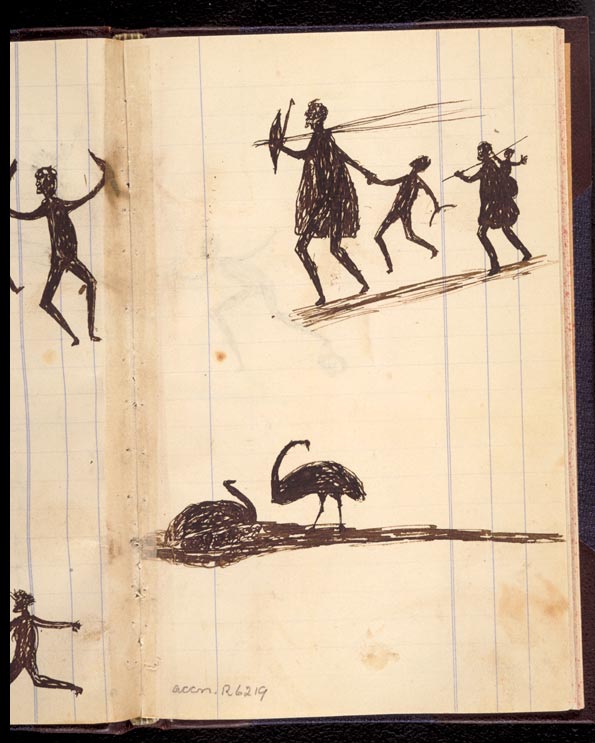Description
This is a black-and-white drawing by an Indigenous Australian artist, Tommy McRae, produced in 1880. It shows six Indigenous people and two emus. Some male figures are carrying weapons and several appear to be wearing possum-skin cloaks. Another adult figure appears to be a woman who is carrying a baby on her back. The half-figure in the bottom left-hand corner is possibly a boy running.
Educational value
- This asset is an artwork by Tommy McRae (c1823-1901) - also known as Tommy Barnes, Yakaduna, and 'Chief of the Wahgunyah tribe', McRae produced the majority of his surviving work at Wahgunyah, in north-central Victoria, in the 1880s and 1890s; his subjects were mainly Indigenous Australian ceremonies, hunting and fighting.
- It is a rare contemporary example of Victorian Indigenous life in the late 1800s produced by an Indigenous person - although McRae and another Indigenous Australian, William Barak (c1824-1903) of Coranderrk, drew their people and culture, most contemporary depictions of Indigenous Australian life in that period were produced by European artists and writers.
- It features an Indigenous artwork that represents a meeting of two cultures - McRae's drawings show some similarities to the pre-European Indigenous rock art in the Grampians region of Victoria, yet they also suggest a strong European influence; McRae used European drawing materials, including paper, pens and pencils and was one of the first Indigenous Australians to be recognised as an artist by the British settlers, who commissioned and bought works from him.
- It depicts Indigenous Australians carrying traditional weapons, including spears, a boomerang, and possibly a woomera - the two adult figures are possibly wearing possum-skin cloaks, although it looks as if they are wearing European dresses; spears were usually carried only by men, and the hemlines of any dresses issued by settlers to Indigenous Australian women in the late 1800s came to well below the knee.
- It depicts two emus - Indigenous Australians in south-east Australia hunted emus for their meat, and used long emu bones as spear points, and to make holes in animal skins that were being sewn together; along with other wildlife important to Indigenous Australians, notably kangaroos, emu numbers became rapidly depleted or were driven beyond traditional territorial boundaries by the arrival of British settlers with their flocks of sheep and herds of cattle.
- It suggests the resilience of traditional Indigenous culture - although McRae's drawings could be partly based on memory, they suggest that Indigenous Australians of the region were still practising aspects of traditional culture in the late 1800s despite the loss of territory and other sudden changes that came with British settlement; the first settlements were established in north-central Victoria in the late 1830s, probably when McRae was a teenager.
- It highlights Tommy McRae, one of 18 'known ancestors' named in a native title claim by the Yorta Yorta people in north-central Victoria - in 1998, Federal Court Judge Howard Olney rejected the claim, ruling that 'the tide of history' had washed away any entitlement Indigenous people may once have had to native title in the region.
- It is one of 17 drawings by Tommy McRae in an 1880 sketchbook held by the National Library of Australia - the drawings depict corroborees and other aspects of Indigenous life.
